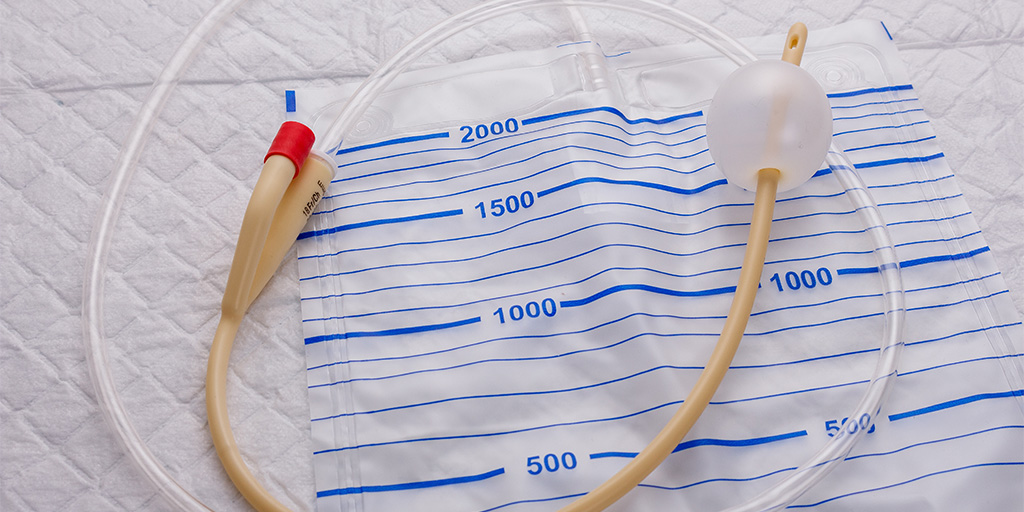The Foley catheter was designed and introduced in the early 1930s as a reliable, self-retaining, balloon-tipped catheter for continuous bladder drainage. Later models introduced adhesive fixation of the catheter to the skin, allowing for long-term, reliable bladder drainage in male and female patients. Foley catheters also allowed physicians to track patients’ urine output accurately. [1] Aside from subtle improvements since the 1930s, the basic design of the Foley catheter remains the same, with antimicrobial and silicone coatings being added to the latex surface to decrease friction, risk of infection, and stricture due to latex reactions. [2] [3] [4]
Despite obvious benefits, using a Foley catheter for urine output management remains a primary source of hospital-acquired infections. According to the CDC, catheter-associated urinary tract infections (CAUTIs) account for more than 30% of hospital-acquired infections, with an estimated 450,000 reported each year. [5] [6] Crucially, a CAUTI is defined as a condition that is not present upon admission but presents itself in patients that have retained an indwelling catheter for more than 48 hours. This indicates that CAUTI diagnoses do not include UTIs observed in patients with catheters placed for less than 48 hours. [5]
Hospital CAUTI rates are calculated by dividing the number of new CAUTI cases by the number of urinary catheter days for a given period and multiplying that by 1000. This means that a patient with a catheter placed for a single day will contribute to the catheter day value but cannot contribute to the CAUTI rate since the indwelling catheter was not in place for 48 hours. However, existing interventions focus on decreasing the number of urinary catheter days in specific patient populations, often by using external catheters. Unfortunately, this intervention results in an increased observed CAUTI rate by reducing the denominator but failing to address the numerator. In a study by Wright et al., decreasing the utilization rate of Foley catheters by 22% resulted in a 6% increase in CAUTI rate due to the disproportionate use of indwelling catheters in higher-risk, catheterized groups. [7]
The CareDry® external urinary management system for women utilizes a novel antimicrobial-embedded sponge to collect and remove urine without needing indwelling catheters or other leak management systems. A medical suction source removes fluid from the sponge, providing instant dryness and increased patient comfort. Antimicrobial agents help to inhibit the growth of both gram-positive and gram-negative bacteria within the sponge, allowing for 67% fewer product changes.
[1] F. Roger CL, H. Ian B, and W. Peter NT, “Urinary catheters: history, current status, adverse events and research,” J Med Eng Technology, pp. 459-470, 2015.
[2] M. Ruutu, O. Alfthan, M. Talja, and L. Andersson, “Cytotoxicity of Latex Urinary Catheters,” British Journal of Urology, vol. 57, pp. 82-87, 1985.
[3] J. Stensballe, D. Looms, P. Nielsen and M. Tvede, “Hydrophilic-Coated Catheters for Intermittent Catheterisation Reduce Urethral Micro Trauma: A Prospective, Randomised, Participant-Blinded, Crossover Study of Three Different Types of Catheter,” European Urology, vol. 48, pp. 978-983, 2005.
[4] J. Johnson, M. Kuskowski and T. Wilt, “Systematic Review: Antimicrobial Urinary Catheters To Prevent Catheter-Associated Urinary Tract Infection in Hospitalized Patients,” Annals of Internal Medicine, vol. 144, pp. 116-126, 2006.
[5] NHSN, “2019 National and State Healthcare-Associated Infections Progress Report,” 2019.
[6] R. Klevens, J. Edwards, C. Richards, T. Horan, R. Gaynes, D. Pollock, and D. Cardo, “Estimating Healthcare-Associated Infections and Deaths in U.S. Hospitals, 2002,” Public Health Reports, 2007.
[7] M. Wright, M. Kharasch, J. Beaumont, L. Peterson, and A. Robicsek, “Reporting Catheter-Associated Urinary Tract Infections: Denominator Matters,” Infection Control and Hospital Epidemiology, vol. 32, no. 7, 2011.
Back to Blog


